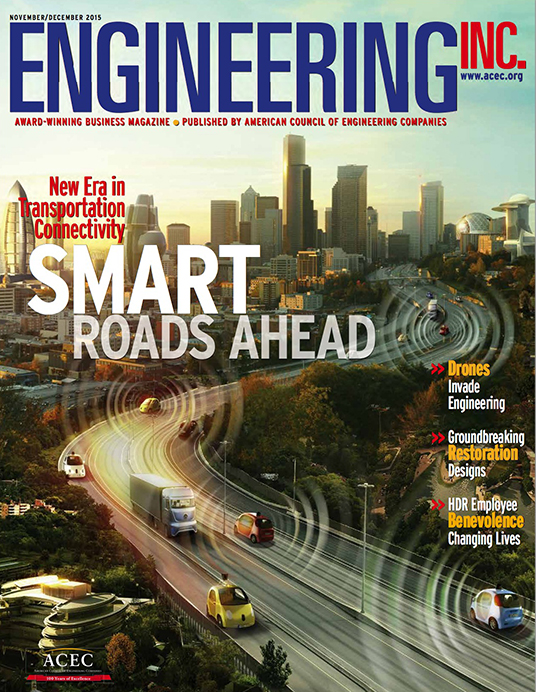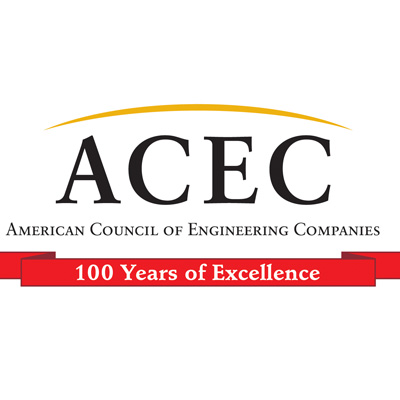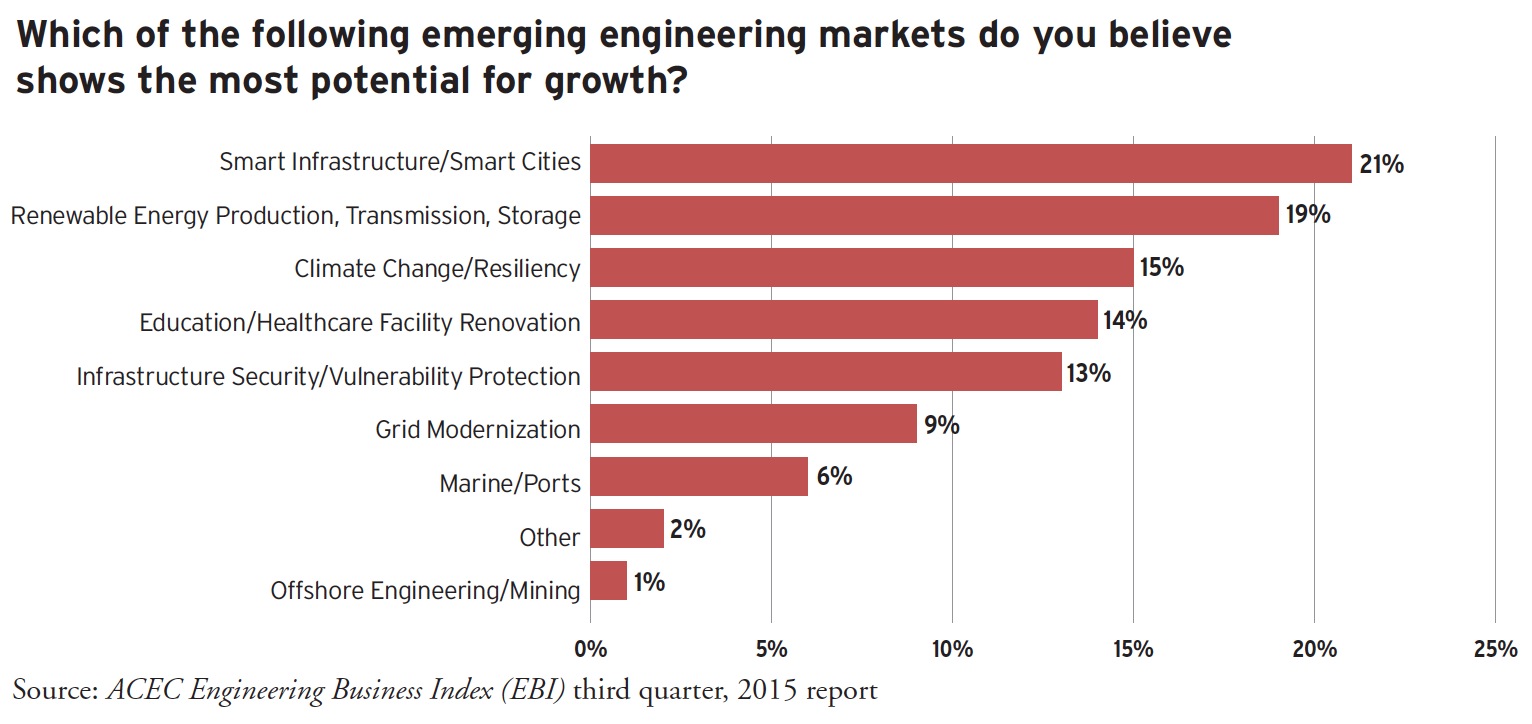AMERICAN COUNCIL OF ENGINEERING COMPANIES
Intelligence in Motion
Smart-vehicle technology prompts new intelligence in transportation infrastructure and opportunities for engineers
-By Samuel Greengard
 The automobile is undergoing a radical transformation. Advancements in technology, along with growing pressure to reduce congestion, trim carbon emissions and improve safety, are fueling the concept of connected cars and smart transportation systems.
The automobile is undergoing a radical transformation. Advancements in technology, along with growing pressure to reduce congestion, trim carbon emissions and improve safety, are fueling the concept of connected cars and smart transportation systems.
Already, automated braking, lane-departure alerts, collision warning and adaptive cruise control systems are available in many vehicles. Meanwhile, Google’s Self-Driving Car project has tallied more than 1 million miles without causing a collision.
How these technological advances will impact America’s roadways is a new challenge facing engineering firms. There’s growing demand to develop smart infrastructure systems that do things such as alter traffic flow dynamically. Motorists are using apps, such as Google Maps and Apple Maps, to bypass congestion and incidents, but far more advanced vehicle-to-vehicle (V2V) communication and vehicle-to-infrastructure (V2X) systems lie ahead.
“There is a lot of research and development focused on automated and autonomous vehicles,” says Matthew Schiemer, vice president of intelligent transportation systems at Gannett Fleming. “Although much of this technology is still well out into the future, there is no question that vehicles and driving will change over the coming years.”
Industry leaders expect that change to provide significant business opportunities for engineers, according to the latest (3rd quarter/2015) ACEC Engineering Business Index (EBI). Results show that “Smart Infrastructure/Smart Cities” was ranked No. 1 by Member Firm leaders (21 percent) among emerging markets they believe show the most potential for growth in the coming years, followed closely by “Renewable Energy Production, Transmission, Storage” (19 percent) and “Climate Change/ Resiliency” (15 percent).
Rolling Forward
It’s no secret that the nation’s highways are in need of technological advancements. According to an August 2015 study conducted by the Texas A&M Transportation Institute, U.S. drivers spent a collective 6.9 billion hours stuck in traffic in 2014. That equates to about 42 hours per year per commuter and collectively wastes $160 billion in time—approximately $960 per motorist. In addition, distracted drivers are a serious problem. Human error is responsible for 70 percent to 80 percent of all vehicle collisions, according to the U.S. Department of Transportation.
“It’s very clear that we need to make infrastructure safer and more efficient,” says Theodore Zoli, national chief bridge engineer at HNTB Corporation. “We need to make investments in smarter vehicles and transportation networks in order to maintain a functional transportation infrastructure and the desired quality of life.”
Automakers are leading the way. They’re moving forward with systems that reduce human input, and the technology is rapidly evolving. Many high-end cars now use sensors to brake automatically if a driver approaches a vehicle too quickly or does not begin to slow at a stop sign. Other vehicles issue alarms and warnings if a driver veers out of a lane without using a turn signal.
General Motors is introducing Super Cruise in the 2017 Cadillac. It takes control of highway steering, acceleration and braking at speeds of up to 70 mph through the use of radar, ultrasonic sensors, onboard cameras and GPS. Mercedes-Benz has already demonstrated a fully autonomous concept car, while Volkswagen, Audi, BMW, Nissan and other manufacturers plan to introduce vehicles that, under good weather conditions, operate without driver input on rural roads and interstate highways. These systems will also apply the brakes or take control of the steering wheel when they detect danger.
The endgame is smarter infrastructure. Today’s informatics systems, including emerging products such as Apple CarPlay and Android Auto, offer basic input about traffic and can suggest alternate routes based on current traffic flow and congestion. “This introduces a level of connectivity that hasn’t previously existed,” says Laura McGovern, senior vice president at engineering firm Alfred Benesch & Company.
As a result, highway designers will need to integrate signals, roads and other infrastructure to create V2V and V2X networks. As McGovern puts it, “Bigger gains are possible when most or all cars on the road are connected and communicating with one another.”
For now, the framework is largely under development, and the federal government is establishing rules, standards and protocols for V2V and V2X systems. These mesh networks will use dedicated short-range communications to communicate with vehicles at a range of 1,000 feet or about 10 seconds at highway speeds. Ultimately, motorists will receive information and warning messages via a visual display or audible alert. In addition to providing alerts when it isn’t safe to enter an intersection or when a vehicle several cars ahead begins braking, these systems would deliver warnings at rail crossings or when black ice appears on roadways. Sensors in roadways or data from other vehicles could alert motorists before they reach an icy patch or a flooded intersection.
What’s more, data from these sensors and vehicles would stream into Traffic Management Centers (TMCs) that monitor and manage conditions and events in real time. This would allow a TMC to adjust traffic signals or lower or raise speed limits, for example. It could also help officials dispatch maintenance crews or snow plows faster and exactly where they’re needed.
Download full article (PDF): Intelligence in Motion
 About the American Council of Engineering Companies
About the American Council of Engineering Companies
www.acec.org
The American Council of Engineering Companies (ACEC) is the voice of America’s engineering industry. Council members – numbering more than 5,000 firms representing more than 500,000 employees throughout the country – are engaged in a wide range of engineering works that propel the nation’s economy, and enhance and safeguard America’s quality of life. These works allow Americans to drink clean water, enjoy a healthy life, take advantage of new technologies, and travel safely and efficiently. The Council’s mission is to contribute to America’s prosperity and welfare by advancing the business interests of member firms.
Tags: ACEC, American Council of Engineering Companies, driverless cars, Engineering Inc., Smart Infrastructure, Smart Roads







 RSS Feed
RSS Feed